Analysis of Mergers and Acquisitions in Corporate Financial Management
VerifiedAdded on 2021/04/16
|14
|4193
|55
Report
AI Summary
This report provides a detailed analysis of mergers and acquisitions (M&A) within the context of corporate financial management. It begins by defining M&A, differentiating between mergers and acquisitions, and highlighting their importance in modern economies. The report explores various rationales behind M&A, including strategic, speculative, failure by management, financial necessity, and political motivations. It examines different forms of consideration in M&A, with a specific focus on cash offers and share exchanges, discussing the advantages and disadvantages of each. The report also touches upon the success and failure rates of M&A, providing a real-world example to illustrate the concepts discussed. Finally, it concludes with recommendations based on the analysis.
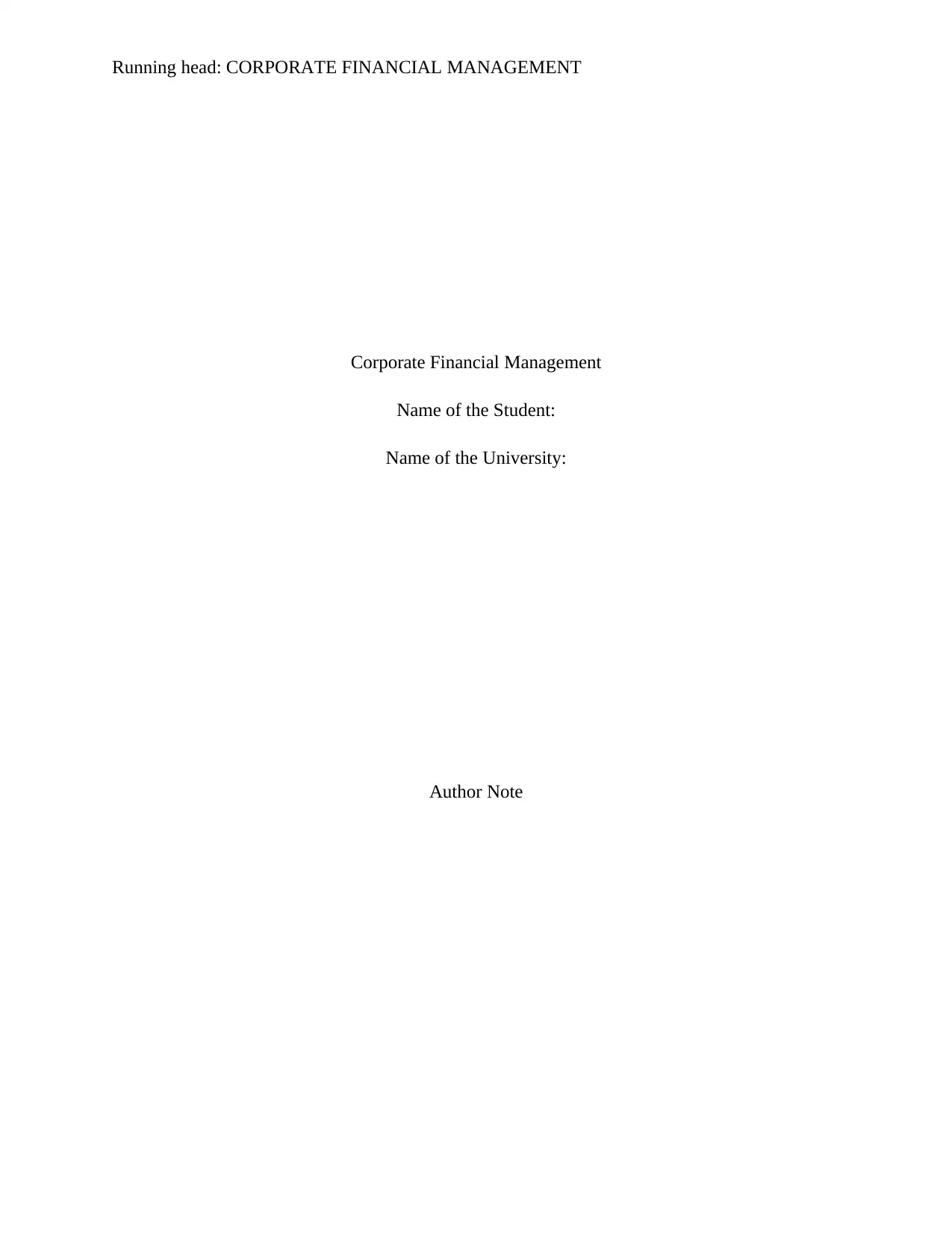
Running head: CORPORATE FINANCIAL MANAGEMENT
Corporate Financial Management
Name of the Student:
Name of the University:
Author Note
Corporate Financial Management
Name of the Student:
Name of the University:
Author Note
Secure Best Marks with AI Grader
Need help grading? Try our AI Grader for instant feedback on your assignments.
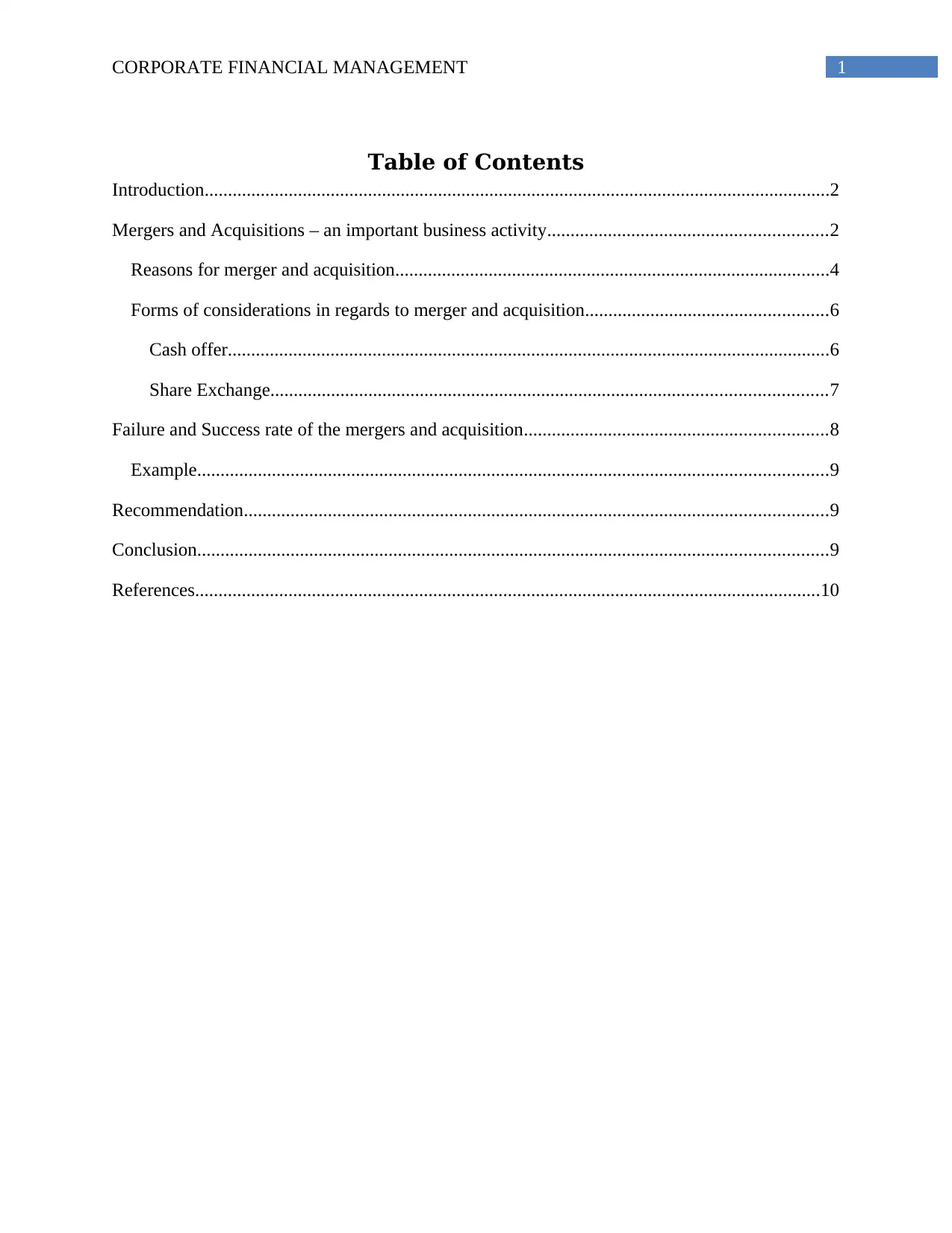
1CORPORATE FINANCIAL MANAGEMENT
Table of Contents
Introduction......................................................................................................................................2
Mergers and Acquisitions – an important business activity............................................................2
Reasons for merger and acquisition.............................................................................................4
Forms of considerations in regards to merger and acquisition....................................................6
Cash offer.................................................................................................................................6
Share Exchange.......................................................................................................................7
Failure and Success rate of the mergers and acquisition.................................................................8
Example.......................................................................................................................................9
Recommendation.............................................................................................................................9
Conclusion.......................................................................................................................................9
References......................................................................................................................................10
Table of Contents
Introduction......................................................................................................................................2
Mergers and Acquisitions – an important business activity............................................................2
Reasons for merger and acquisition.............................................................................................4
Forms of considerations in regards to merger and acquisition....................................................6
Cash offer.................................................................................................................................6
Share Exchange.......................................................................................................................7
Failure and Success rate of the mergers and acquisition.................................................................8
Example.......................................................................................................................................9
Recommendation.............................................................................................................................9
Conclusion.......................................................................................................................................9
References......................................................................................................................................10
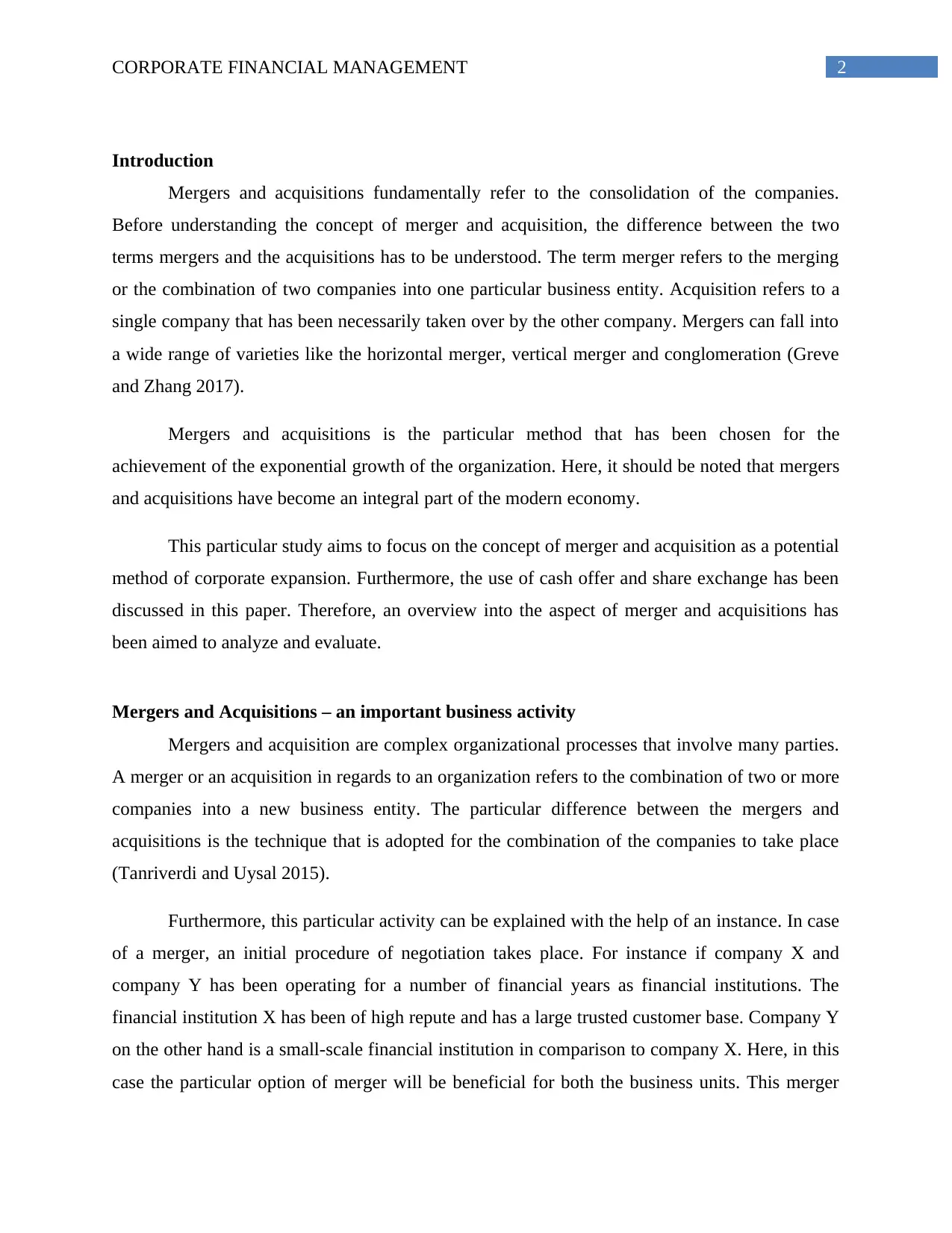
2CORPORATE FINANCIAL MANAGEMENT
Introduction
Mergers and acquisitions fundamentally refer to the consolidation of the companies.
Before understanding the concept of merger and acquisition, the difference between the two
terms mergers and the acquisitions has to be understood. The term merger refers to the merging
or the combination of two companies into one particular business entity. Acquisition refers to a
single company that has been necessarily taken over by the other company. Mergers can fall into
a wide range of varieties like the horizontal merger, vertical merger and conglomeration (Greve
and Zhang 2017).
Mergers and acquisitions is the particular method that has been chosen for the
achievement of the exponential growth of the organization. Here, it should be noted that mergers
and acquisitions have become an integral part of the modern economy.
This particular study aims to focus on the concept of merger and acquisition as a potential
method of corporate expansion. Furthermore, the use of cash offer and share exchange has been
discussed in this paper. Therefore, an overview into the aspect of merger and acquisitions has
been aimed to analyze and evaluate.
Mergers and Acquisitions – an important business activity
Mergers and acquisition are complex organizational processes that involve many parties.
A merger or an acquisition in regards to an organization refers to the combination of two or more
companies into a new business entity. The particular difference between the mergers and
acquisitions is the technique that is adopted for the combination of the companies to take place
(Tanriverdi and Uysal 2015).
Furthermore, this particular activity can be explained with the help of an instance. In case
of a merger, an initial procedure of negotiation takes place. For instance if company X and
company Y has been operating for a number of financial years as financial institutions. The
financial institution X has been of high repute and has a large trusted customer base. Company Y
on the other hand is a small-scale financial institution in comparison to company X. Here, in this
case the particular option of merger will be beneficial for both the business units. This merger
Introduction
Mergers and acquisitions fundamentally refer to the consolidation of the companies.
Before understanding the concept of merger and acquisition, the difference between the two
terms mergers and the acquisitions has to be understood. The term merger refers to the merging
or the combination of two companies into one particular business entity. Acquisition refers to a
single company that has been necessarily taken over by the other company. Mergers can fall into
a wide range of varieties like the horizontal merger, vertical merger and conglomeration (Greve
and Zhang 2017).
Mergers and acquisitions is the particular method that has been chosen for the
achievement of the exponential growth of the organization. Here, it should be noted that mergers
and acquisitions have become an integral part of the modern economy.
This particular study aims to focus on the concept of merger and acquisition as a potential
method of corporate expansion. Furthermore, the use of cash offer and share exchange has been
discussed in this paper. Therefore, an overview into the aspect of merger and acquisitions has
been aimed to analyze and evaluate.
Mergers and Acquisitions – an important business activity
Mergers and acquisition are complex organizational processes that involve many parties.
A merger or an acquisition in regards to an organization refers to the combination of two or more
companies into a new business entity. The particular difference between the mergers and
acquisitions is the technique that is adopted for the combination of the companies to take place
(Tanriverdi and Uysal 2015).
Furthermore, this particular activity can be explained with the help of an instance. In case
of a merger, an initial procedure of negotiation takes place. For instance if company X and
company Y has been operating for a number of financial years as financial institutions. The
financial institution X has been of high repute and has a large trusted customer base. Company Y
on the other hand is a small-scale financial institution in comparison to company X. Here, in this
case the particular option of merger will be beneficial for both the business units. This merger
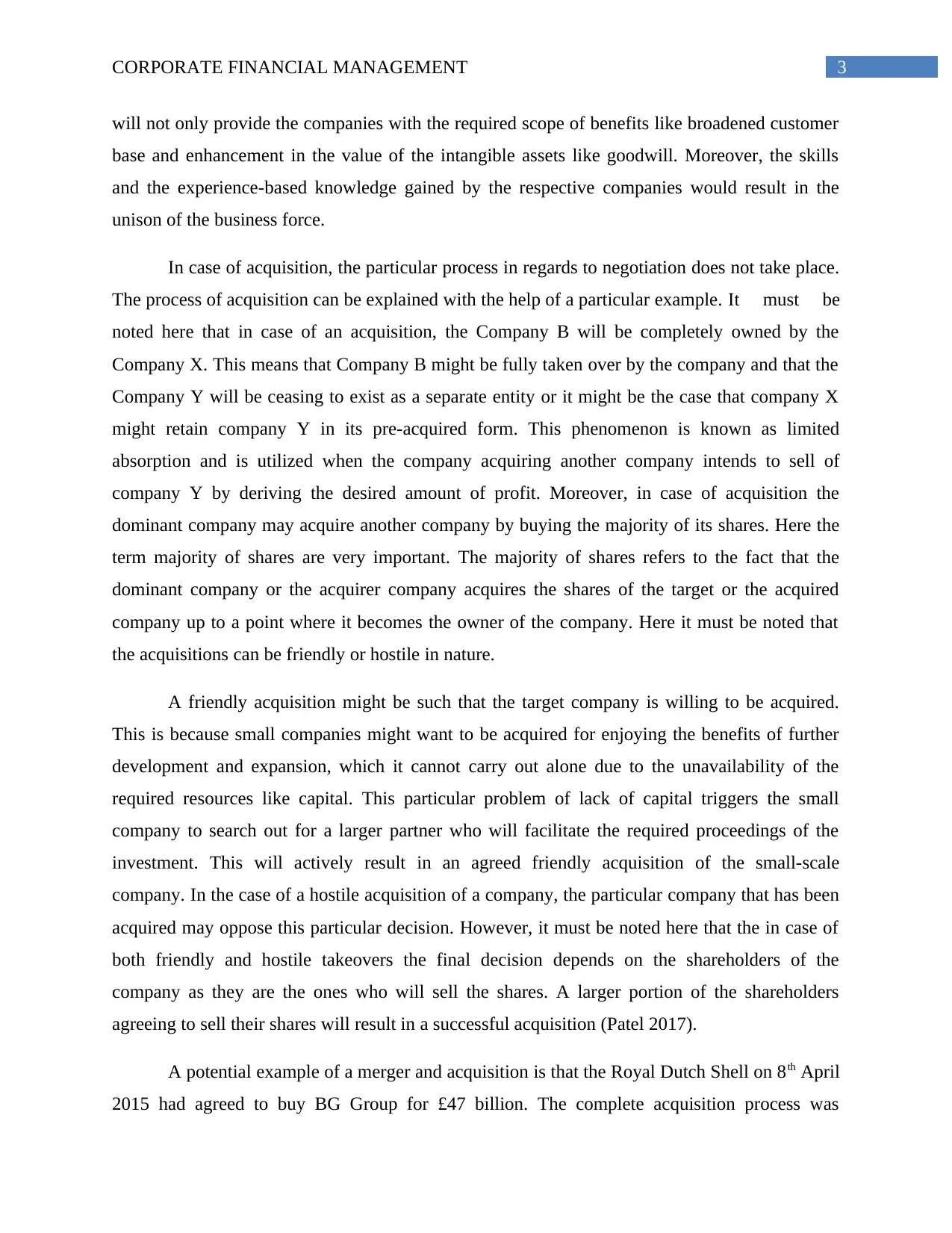
3CORPORATE FINANCIAL MANAGEMENT
will not only provide the companies with the required scope of benefits like broadened customer
base and enhancement in the value of the intangible assets like goodwill. Moreover, the skills
and the experience-based knowledge gained by the respective companies would result in the
unison of the business force.
In case of acquisition, the particular process in regards to negotiation does not take place.
The process of acquisition can be explained with the help of a particular example. It must be
noted here that in case of an acquisition, the Company B will be completely owned by the
Company X. This means that Company B might be fully taken over by the company and that the
Company Y will be ceasing to exist as a separate entity or it might be the case that company X
might retain company Y in its pre-acquired form. This phenomenon is known as limited
absorption and is utilized when the company acquiring another company intends to sell of
company Y by deriving the desired amount of profit. Moreover, in case of acquisition the
dominant company may acquire another company by buying the majority of its shares. Here the
term majority of shares are very important. The majority of shares refers to the fact that the
dominant company or the acquirer company acquires the shares of the target or the acquired
company up to a point where it becomes the owner of the company. Here it must be noted that
the acquisitions can be friendly or hostile in nature.
A friendly acquisition might be such that the target company is willing to be acquired.
This is because small companies might want to be acquired for enjoying the benefits of further
development and expansion, which it cannot carry out alone due to the unavailability of the
required resources like capital. This particular problem of lack of capital triggers the small
company to search out for a larger partner who will facilitate the required proceedings of the
investment. This will actively result in an agreed friendly acquisition of the small-scale
company. In the case of a hostile acquisition of a company, the particular company that has been
acquired may oppose this particular decision. However, it must be noted here that the in case of
both friendly and hostile takeovers the final decision depends on the shareholders of the
company as they are the ones who will sell the shares. A larger portion of the shareholders
agreeing to sell their shares will result in a successful acquisition (Patel 2017).
A potential example of a merger and acquisition is that the Royal Dutch Shell on 8th April
2015 had agreed to buy BG Group for £47 billion. The complete acquisition process was
will not only provide the companies with the required scope of benefits like broadened customer
base and enhancement in the value of the intangible assets like goodwill. Moreover, the skills
and the experience-based knowledge gained by the respective companies would result in the
unison of the business force.
In case of acquisition, the particular process in regards to negotiation does not take place.
The process of acquisition can be explained with the help of a particular example. It must be
noted here that in case of an acquisition, the Company B will be completely owned by the
Company X. This means that Company B might be fully taken over by the company and that the
Company Y will be ceasing to exist as a separate entity or it might be the case that company X
might retain company Y in its pre-acquired form. This phenomenon is known as limited
absorption and is utilized when the company acquiring another company intends to sell of
company Y by deriving the desired amount of profit. Moreover, in case of acquisition the
dominant company may acquire another company by buying the majority of its shares. Here the
term majority of shares are very important. The majority of shares refers to the fact that the
dominant company or the acquirer company acquires the shares of the target or the acquired
company up to a point where it becomes the owner of the company. Here it must be noted that
the acquisitions can be friendly or hostile in nature.
A friendly acquisition might be such that the target company is willing to be acquired.
This is because small companies might want to be acquired for enjoying the benefits of further
development and expansion, which it cannot carry out alone due to the unavailability of the
required resources like capital. This particular problem of lack of capital triggers the small
company to search out for a larger partner who will facilitate the required proceedings of the
investment. This will actively result in an agreed friendly acquisition of the small-scale
company. In the case of a hostile acquisition of a company, the particular company that has been
acquired may oppose this particular decision. However, it must be noted here that the in case of
both friendly and hostile takeovers the final decision depends on the shareholders of the
company as they are the ones who will sell the shares. A larger portion of the shareholders
agreeing to sell their shares will result in a successful acquisition (Patel 2017).
A potential example of a merger and acquisition is that the Royal Dutch Shell on 8th April
2015 had agreed to buy BG Group for £47 billion. The complete acquisition process was
Secure Best Marks with AI Grader
Need help grading? Try our AI Grader for instant feedback on your assignments.
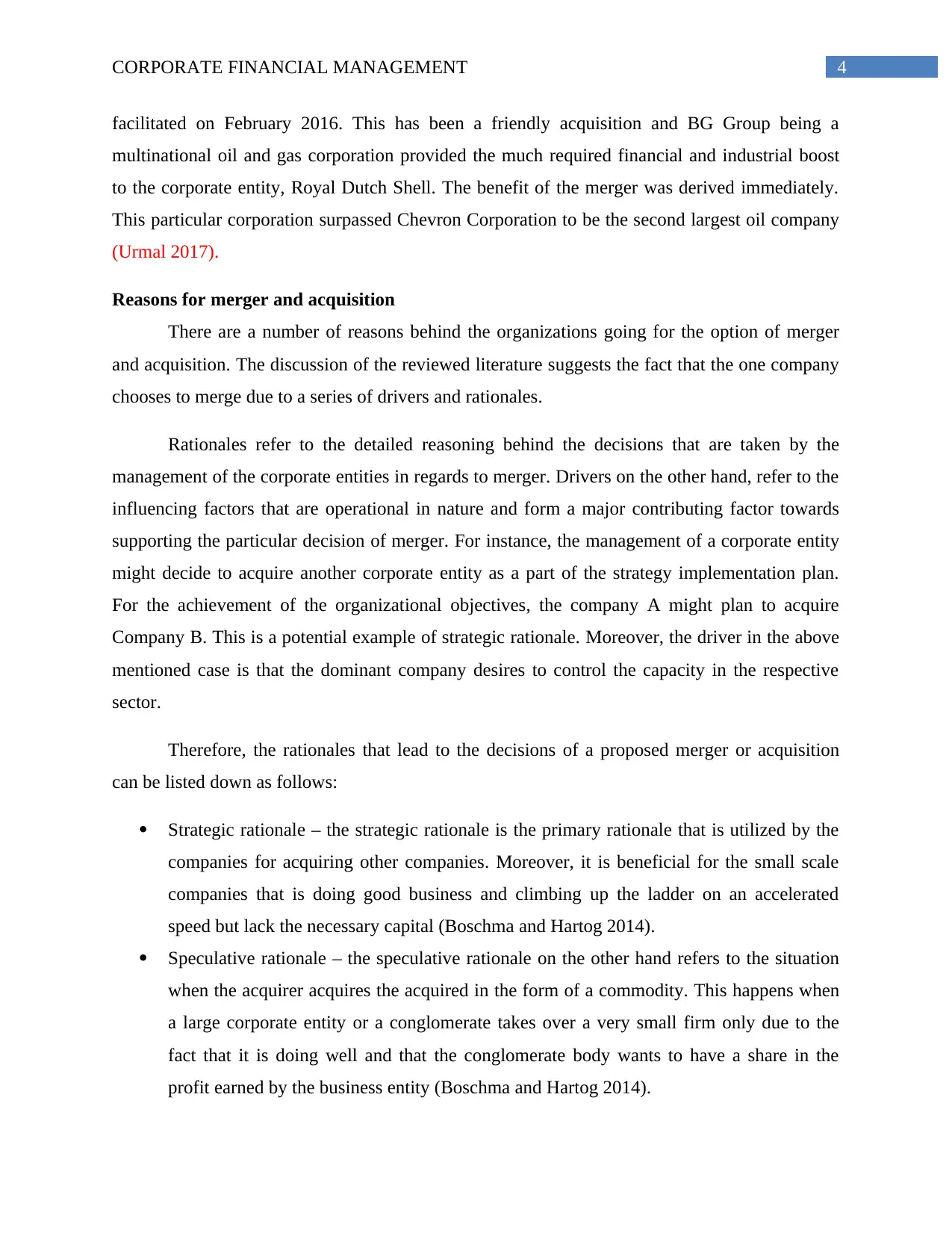
4CORPORATE FINANCIAL MANAGEMENT
facilitated on February 2016. This has been a friendly acquisition and BG Group being a
multinational oil and gas corporation provided the much required financial and industrial boost
to the corporate entity, Royal Dutch Shell. The benefit of the merger was derived immediately.
This particular corporation surpassed Chevron Corporation to be the second largest oil company
(Urmal 2017).
Reasons for merger and acquisition
There are a number of reasons behind the organizations going for the option of merger
and acquisition. The discussion of the reviewed literature suggests the fact that the one company
chooses to merge due to a series of drivers and rationales.
Rationales refer to the detailed reasoning behind the decisions that are taken by the
management of the corporate entities in regards to merger. Drivers on the other hand, refer to the
influencing factors that are operational in nature and form a major contributing factor towards
supporting the particular decision of merger. For instance, the management of a corporate entity
might decide to acquire another corporate entity as a part of the strategy implementation plan.
For the achievement of the organizational objectives, the company A might plan to acquire
Company B. This is a potential example of strategic rationale. Moreover, the driver in the above
mentioned case is that the dominant company desires to control the capacity in the respective
sector.
Therefore, the rationales that lead to the decisions of a proposed merger or acquisition
can be listed down as follows:
Strategic rationale – the strategic rationale is the primary rationale that is utilized by the
companies for acquiring other companies. Moreover, it is beneficial for the small scale
companies that is doing good business and climbing up the ladder on an accelerated
speed but lack the necessary capital (Boschma and Hartog 2014).
Speculative rationale – the speculative rationale on the other hand refers to the situation
when the acquirer acquires the acquired in the form of a commodity. This happens when
a large corporate entity or a conglomerate takes over a very small firm only due to the
fact that it is doing well and that the conglomerate body wants to have a share in the
profit earned by the business entity (Boschma and Hartog 2014).
facilitated on February 2016. This has been a friendly acquisition and BG Group being a
multinational oil and gas corporation provided the much required financial and industrial boost
to the corporate entity, Royal Dutch Shell. The benefit of the merger was derived immediately.
This particular corporation surpassed Chevron Corporation to be the second largest oil company
(Urmal 2017).
Reasons for merger and acquisition
There are a number of reasons behind the organizations going for the option of merger
and acquisition. The discussion of the reviewed literature suggests the fact that the one company
chooses to merge due to a series of drivers and rationales.
Rationales refer to the detailed reasoning behind the decisions that are taken by the
management of the corporate entities in regards to merger. Drivers on the other hand, refer to the
influencing factors that are operational in nature and form a major contributing factor towards
supporting the particular decision of merger. For instance, the management of a corporate entity
might decide to acquire another corporate entity as a part of the strategy implementation plan.
For the achievement of the organizational objectives, the company A might plan to acquire
Company B. This is a potential example of strategic rationale. Moreover, the driver in the above
mentioned case is that the dominant company desires to control the capacity in the respective
sector.
Therefore, the rationales that lead to the decisions of a proposed merger or acquisition
can be listed down as follows:
Strategic rationale – the strategic rationale is the primary rationale that is utilized by the
companies for acquiring other companies. Moreover, it is beneficial for the small scale
companies that is doing good business and climbing up the ladder on an accelerated
speed but lack the necessary capital (Boschma and Hartog 2014).
Speculative rationale – the speculative rationale on the other hand refers to the situation
when the acquirer acquires the acquired in the form of a commodity. This happens when
a large corporate entity or a conglomerate takes over a very small firm only due to the
fact that it is doing well and that the conglomerate body wants to have a share in the
profit earned by the business entity (Boschma and Hartog 2014).
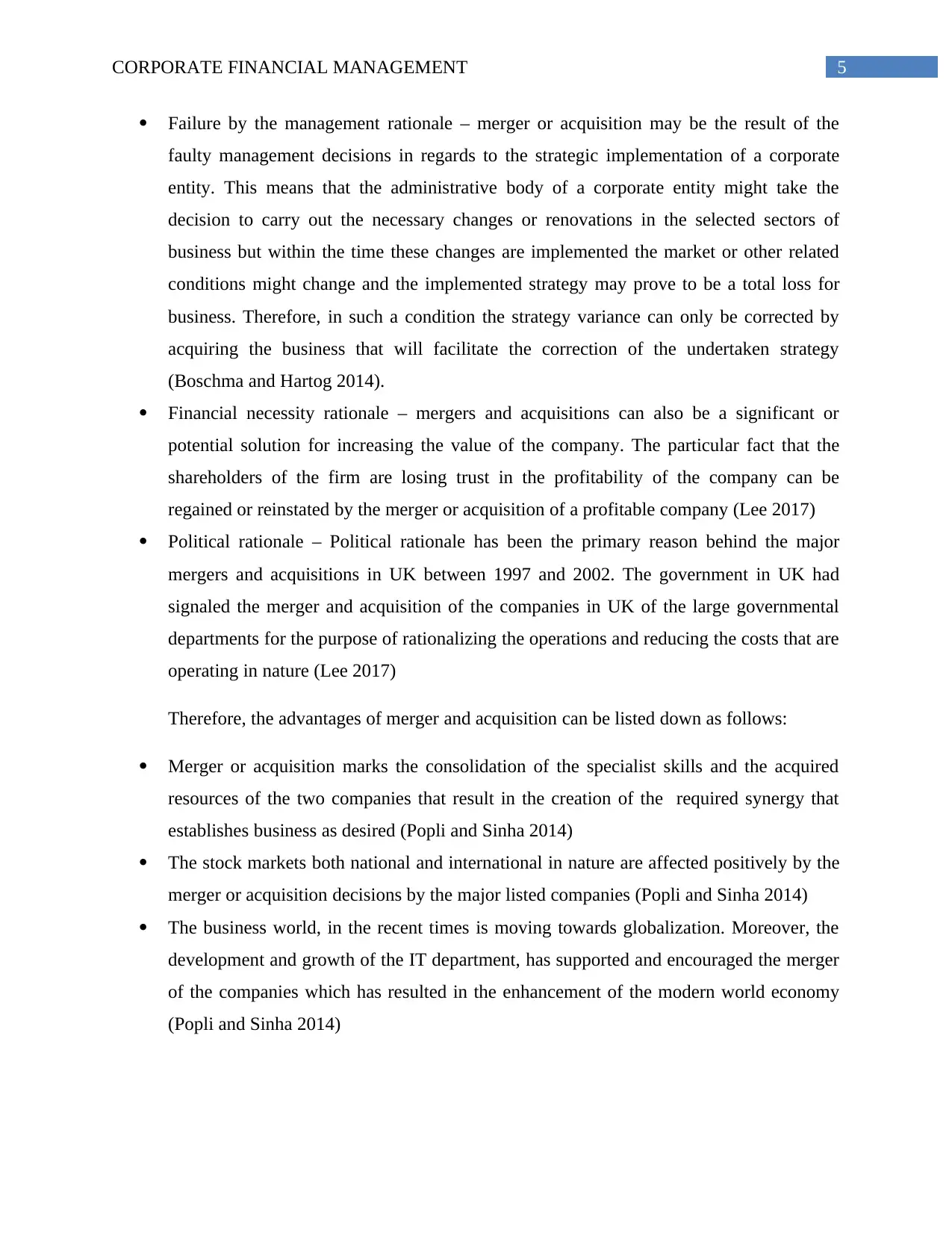
5CORPORATE FINANCIAL MANAGEMENT
Failure by the management rationale – merger or acquisition may be the result of the
faulty management decisions in regards to the strategic implementation of a corporate
entity. This means that the administrative body of a corporate entity might take the
decision to carry out the necessary changes or renovations in the selected sectors of
business but within the time these changes are implemented the market or other related
conditions might change and the implemented strategy may prove to be a total loss for
business. Therefore, in such a condition the strategy variance can only be corrected by
acquiring the business that will facilitate the correction of the undertaken strategy
(Boschma and Hartog 2014).
Financial necessity rationale – mergers and acquisitions can also be a significant or
potential solution for increasing the value of the company. The particular fact that the
shareholders of the firm are losing trust in the profitability of the company can be
regained or reinstated by the merger or acquisition of a profitable company (Lee 2017)
Political rationale – Political rationale has been the primary reason behind the major
mergers and acquisitions in UK between 1997 and 2002. The government in UK had
signaled the merger and acquisition of the companies in UK of the large governmental
departments for the purpose of rationalizing the operations and reducing the costs that are
operating in nature (Lee 2017)
Therefore, the advantages of merger and acquisition can be listed down as follows:
Merger or acquisition marks the consolidation of the specialist skills and the acquired
resources of the two companies that result in the creation of the required synergy that
establishes business as desired (Popli and Sinha 2014)
The stock markets both national and international in nature are affected positively by the
merger or acquisition decisions by the major listed companies (Popli and Sinha 2014)
The business world, in the recent times is moving towards globalization. Moreover, the
development and growth of the IT department, has supported and encouraged the merger
of the companies which has resulted in the enhancement of the modern world economy
(Popli and Sinha 2014)
Failure by the management rationale – merger or acquisition may be the result of the
faulty management decisions in regards to the strategic implementation of a corporate
entity. This means that the administrative body of a corporate entity might take the
decision to carry out the necessary changes or renovations in the selected sectors of
business but within the time these changes are implemented the market or other related
conditions might change and the implemented strategy may prove to be a total loss for
business. Therefore, in such a condition the strategy variance can only be corrected by
acquiring the business that will facilitate the correction of the undertaken strategy
(Boschma and Hartog 2014).
Financial necessity rationale – mergers and acquisitions can also be a significant or
potential solution for increasing the value of the company. The particular fact that the
shareholders of the firm are losing trust in the profitability of the company can be
regained or reinstated by the merger or acquisition of a profitable company (Lee 2017)
Political rationale – Political rationale has been the primary reason behind the major
mergers and acquisitions in UK between 1997 and 2002. The government in UK had
signaled the merger and acquisition of the companies in UK of the large governmental
departments for the purpose of rationalizing the operations and reducing the costs that are
operating in nature (Lee 2017)
Therefore, the advantages of merger and acquisition can be listed down as follows:
Merger or acquisition marks the consolidation of the specialist skills and the acquired
resources of the two companies that result in the creation of the required synergy that
establishes business as desired (Popli and Sinha 2014)
The stock markets both national and international in nature are affected positively by the
merger or acquisition decisions by the major listed companies (Popli and Sinha 2014)
The business world, in the recent times is moving towards globalization. Moreover, the
development and growth of the IT department, has supported and encouraged the merger
of the companies which has resulted in the enhancement of the modern world economy
(Popli and Sinha 2014)
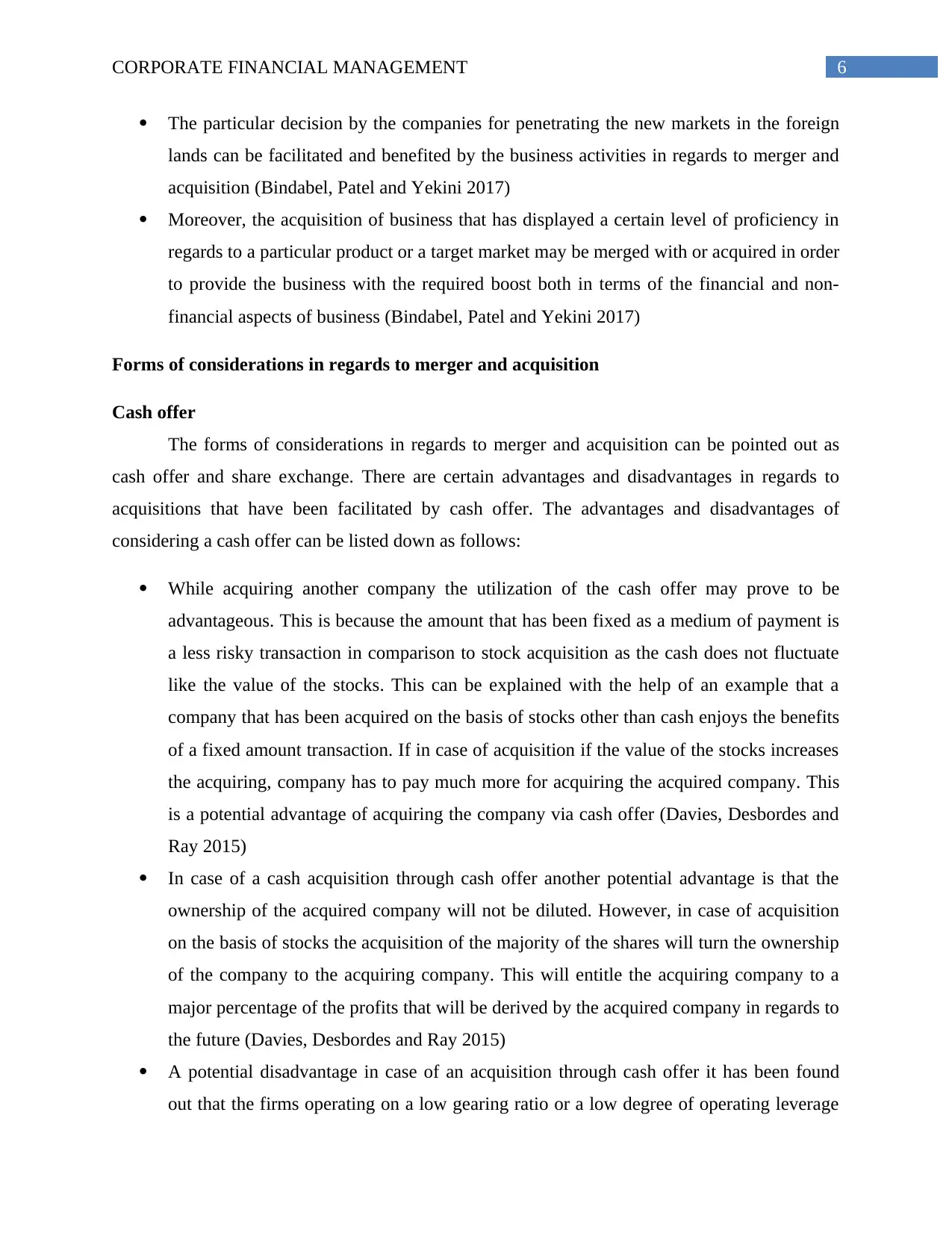
6CORPORATE FINANCIAL MANAGEMENT
The particular decision by the companies for penetrating the new markets in the foreign
lands can be facilitated and benefited by the business activities in regards to merger and
acquisition (Bindabel, Patel and Yekini 2017)
Moreover, the acquisition of business that has displayed a certain level of proficiency in
regards to a particular product or a target market may be merged with or acquired in order
to provide the business with the required boost both in terms of the financial and non-
financial aspects of business (Bindabel, Patel and Yekini 2017)
Forms of considerations in regards to merger and acquisition
Cash offer
The forms of considerations in regards to merger and acquisition can be pointed out as
cash offer and share exchange. There are certain advantages and disadvantages in regards to
acquisitions that have been facilitated by cash offer. The advantages and disadvantages of
considering a cash offer can be listed down as follows:
While acquiring another company the utilization of the cash offer may prove to be
advantageous. This is because the amount that has been fixed as a medium of payment is
a less risky transaction in comparison to stock acquisition as the cash does not fluctuate
like the value of the stocks. This can be explained with the help of an example that a
company that has been acquired on the basis of stocks other than cash enjoys the benefits
of a fixed amount transaction. If in case of acquisition if the value of the stocks increases
the acquiring, company has to pay much more for acquiring the acquired company. This
is a potential advantage of acquiring the company via cash offer (Davies, Desbordes and
Ray 2015)
In case of a cash acquisition through cash offer another potential advantage is that the
ownership of the acquired company will not be diluted. However, in case of acquisition
on the basis of stocks the acquisition of the majority of the shares will turn the ownership
of the company to the acquiring company. This will entitle the acquiring company to a
major percentage of the profits that will be derived by the acquired company in regards to
the future (Davies, Desbordes and Ray 2015)
A potential disadvantage in case of an acquisition through cash offer it has been found
out that the firms operating on a low gearing ratio or a low degree of operating leverage
The particular decision by the companies for penetrating the new markets in the foreign
lands can be facilitated and benefited by the business activities in regards to merger and
acquisition (Bindabel, Patel and Yekini 2017)
Moreover, the acquisition of business that has displayed a certain level of proficiency in
regards to a particular product or a target market may be merged with or acquired in order
to provide the business with the required boost both in terms of the financial and non-
financial aspects of business (Bindabel, Patel and Yekini 2017)
Forms of considerations in regards to merger and acquisition
Cash offer
The forms of considerations in regards to merger and acquisition can be pointed out as
cash offer and share exchange. There are certain advantages and disadvantages in regards to
acquisitions that have been facilitated by cash offer. The advantages and disadvantages of
considering a cash offer can be listed down as follows:
While acquiring another company the utilization of the cash offer may prove to be
advantageous. This is because the amount that has been fixed as a medium of payment is
a less risky transaction in comparison to stock acquisition as the cash does not fluctuate
like the value of the stocks. This can be explained with the help of an example that a
company that has been acquired on the basis of stocks other than cash enjoys the benefits
of a fixed amount transaction. If in case of acquisition if the value of the stocks increases
the acquiring, company has to pay much more for acquiring the acquired company. This
is a potential advantage of acquiring the company via cash offer (Davies, Desbordes and
Ray 2015)
In case of a cash acquisition through cash offer another potential advantage is that the
ownership of the acquired company will not be diluted. However, in case of acquisition
on the basis of stocks the acquisition of the majority of the shares will turn the ownership
of the company to the acquiring company. This will entitle the acquiring company to a
major percentage of the profits that will be derived by the acquired company in regards to
the future (Davies, Desbordes and Ray 2015)
A potential disadvantage in case of an acquisition through cash offer it has been found
out that the firms operating on a low gearing ratio or a low degree of operating leverage
Paraphrase This Document
Need a fresh take? Get an instant paraphrase of this document with our AI Paraphraser
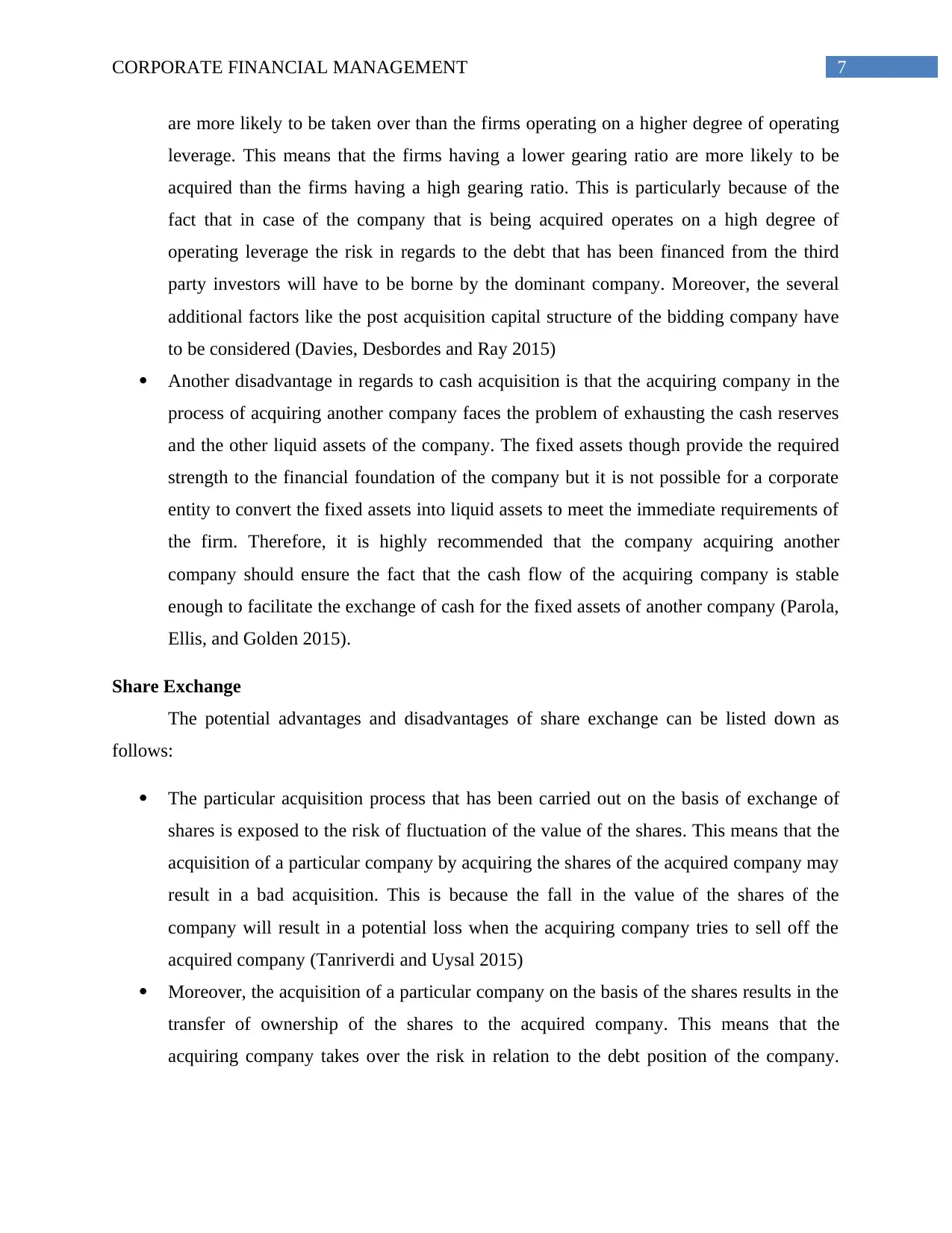
7CORPORATE FINANCIAL MANAGEMENT
are more likely to be taken over than the firms operating on a higher degree of operating
leverage. This means that the firms having a lower gearing ratio are more likely to be
acquired than the firms having a high gearing ratio. This is particularly because of the
fact that in case of the company that is being acquired operates on a high degree of
operating leverage the risk in regards to the debt that has been financed from the third
party investors will have to be borne by the dominant company. Moreover, the several
additional factors like the post acquisition capital structure of the bidding company have
to be considered (Davies, Desbordes and Ray 2015)
Another disadvantage in regards to cash acquisition is that the acquiring company in the
process of acquiring another company faces the problem of exhausting the cash reserves
and the other liquid assets of the company. The fixed assets though provide the required
strength to the financial foundation of the company but it is not possible for a corporate
entity to convert the fixed assets into liquid assets to meet the immediate requirements of
the firm. Therefore, it is highly recommended that the company acquiring another
company should ensure the fact that the cash flow of the acquiring company is stable
enough to facilitate the exchange of cash for the fixed assets of another company (Parola,
Ellis, and Golden 2015).
Share Exchange
The potential advantages and disadvantages of share exchange can be listed down as
follows:
The particular acquisition process that has been carried out on the basis of exchange of
shares is exposed to the risk of fluctuation of the value of the shares. This means that the
acquisition of a particular company by acquiring the shares of the acquired company may
result in a bad acquisition. This is because the fall in the value of the shares of the
company will result in a potential loss when the acquiring company tries to sell off the
acquired company (Tanriverdi and Uysal 2015)
Moreover, the acquisition of a particular company on the basis of the shares results in the
transfer of ownership of the shares to the acquired company. This means that the
acquiring company takes over the risk in relation to the debt position of the company.
are more likely to be taken over than the firms operating on a higher degree of operating
leverage. This means that the firms having a lower gearing ratio are more likely to be
acquired than the firms having a high gearing ratio. This is particularly because of the
fact that in case of the company that is being acquired operates on a high degree of
operating leverage the risk in regards to the debt that has been financed from the third
party investors will have to be borne by the dominant company. Moreover, the several
additional factors like the post acquisition capital structure of the bidding company have
to be considered (Davies, Desbordes and Ray 2015)
Another disadvantage in regards to cash acquisition is that the acquiring company in the
process of acquiring another company faces the problem of exhausting the cash reserves
and the other liquid assets of the company. The fixed assets though provide the required
strength to the financial foundation of the company but it is not possible for a corporate
entity to convert the fixed assets into liquid assets to meet the immediate requirements of
the firm. Therefore, it is highly recommended that the company acquiring another
company should ensure the fact that the cash flow of the acquiring company is stable
enough to facilitate the exchange of cash for the fixed assets of another company (Parola,
Ellis, and Golden 2015).
Share Exchange
The potential advantages and disadvantages of share exchange can be listed down as
follows:
The particular acquisition process that has been carried out on the basis of exchange of
shares is exposed to the risk of fluctuation of the value of the shares. This means that the
acquisition of a particular company by acquiring the shares of the acquired company may
result in a bad acquisition. This is because the fall in the value of the shares of the
company will result in a potential loss when the acquiring company tries to sell off the
acquired company (Tanriverdi and Uysal 2015)
Moreover, the acquisition of a particular company on the basis of the shares results in the
transfer of ownership of the shares to the acquired company. This means that the
acquiring company takes over the risk in relation to the debt position of the company.
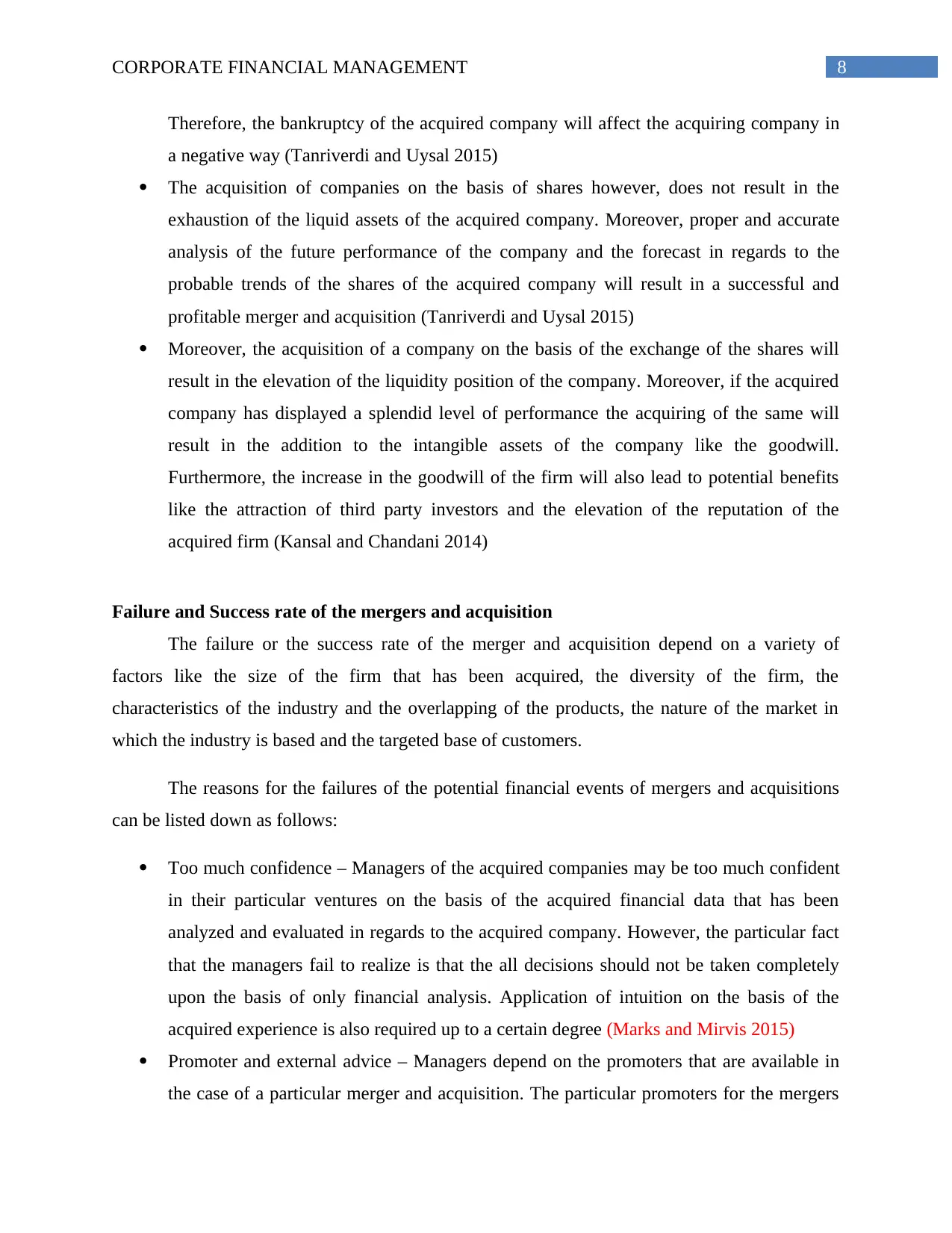
8CORPORATE FINANCIAL MANAGEMENT
Therefore, the bankruptcy of the acquired company will affect the acquiring company in
a negative way (Tanriverdi and Uysal 2015)
The acquisition of companies on the basis of shares however, does not result in the
exhaustion of the liquid assets of the acquired company. Moreover, proper and accurate
analysis of the future performance of the company and the forecast in regards to the
probable trends of the shares of the acquired company will result in a successful and
profitable merger and acquisition (Tanriverdi and Uysal 2015)
Moreover, the acquisition of a company on the basis of the exchange of the shares will
result in the elevation of the liquidity position of the company. Moreover, if the acquired
company has displayed a splendid level of performance the acquiring of the same will
result in the addition to the intangible assets of the company like the goodwill.
Furthermore, the increase in the goodwill of the firm will also lead to potential benefits
like the attraction of third party investors and the elevation of the reputation of the
acquired firm (Kansal and Chandani 2014)
Failure and Success rate of the mergers and acquisition
The failure or the success rate of the merger and acquisition depend on a variety of
factors like the size of the firm that has been acquired, the diversity of the firm, the
characteristics of the industry and the overlapping of the products, the nature of the market in
which the industry is based and the targeted base of customers.
The reasons for the failures of the potential financial events of mergers and acquisitions
can be listed down as follows:
Too much confidence – Managers of the acquired companies may be too much confident
in their particular ventures on the basis of the acquired financial data that has been
analyzed and evaluated in regards to the acquired company. However, the particular fact
that the managers fail to realize is that the all decisions should not be taken completely
upon the basis of only financial analysis. Application of intuition on the basis of the
acquired experience is also required up to a certain degree (Marks and Mirvis 2015)
Promoter and external advice – Managers depend on the promoters that are available in
the case of a particular merger and acquisition. The particular promoters for the mergers
Therefore, the bankruptcy of the acquired company will affect the acquiring company in
a negative way (Tanriverdi and Uysal 2015)
The acquisition of companies on the basis of shares however, does not result in the
exhaustion of the liquid assets of the acquired company. Moreover, proper and accurate
analysis of the future performance of the company and the forecast in regards to the
probable trends of the shares of the acquired company will result in a successful and
profitable merger and acquisition (Tanriverdi and Uysal 2015)
Moreover, the acquisition of a company on the basis of the exchange of the shares will
result in the elevation of the liquidity position of the company. Moreover, if the acquired
company has displayed a splendid level of performance the acquiring of the same will
result in the addition to the intangible assets of the company like the goodwill.
Furthermore, the increase in the goodwill of the firm will also lead to potential benefits
like the attraction of third party investors and the elevation of the reputation of the
acquired firm (Kansal and Chandani 2014)
Failure and Success rate of the mergers and acquisition
The failure or the success rate of the merger and acquisition depend on a variety of
factors like the size of the firm that has been acquired, the diversity of the firm, the
characteristics of the industry and the overlapping of the products, the nature of the market in
which the industry is based and the targeted base of customers.
The reasons for the failures of the potential financial events of mergers and acquisitions
can be listed down as follows:
Too much confidence – Managers of the acquired companies may be too much confident
in their particular ventures on the basis of the acquired financial data that has been
analyzed and evaluated in regards to the acquired company. However, the particular fact
that the managers fail to realize is that the all decisions should not be taken completely
upon the basis of only financial analysis. Application of intuition on the basis of the
acquired experience is also required up to a certain degree (Marks and Mirvis 2015)
Promoter and external advice – Managers depend on the promoters that are available in
the case of a particular merger and acquisition. The particular promoters for the mergers
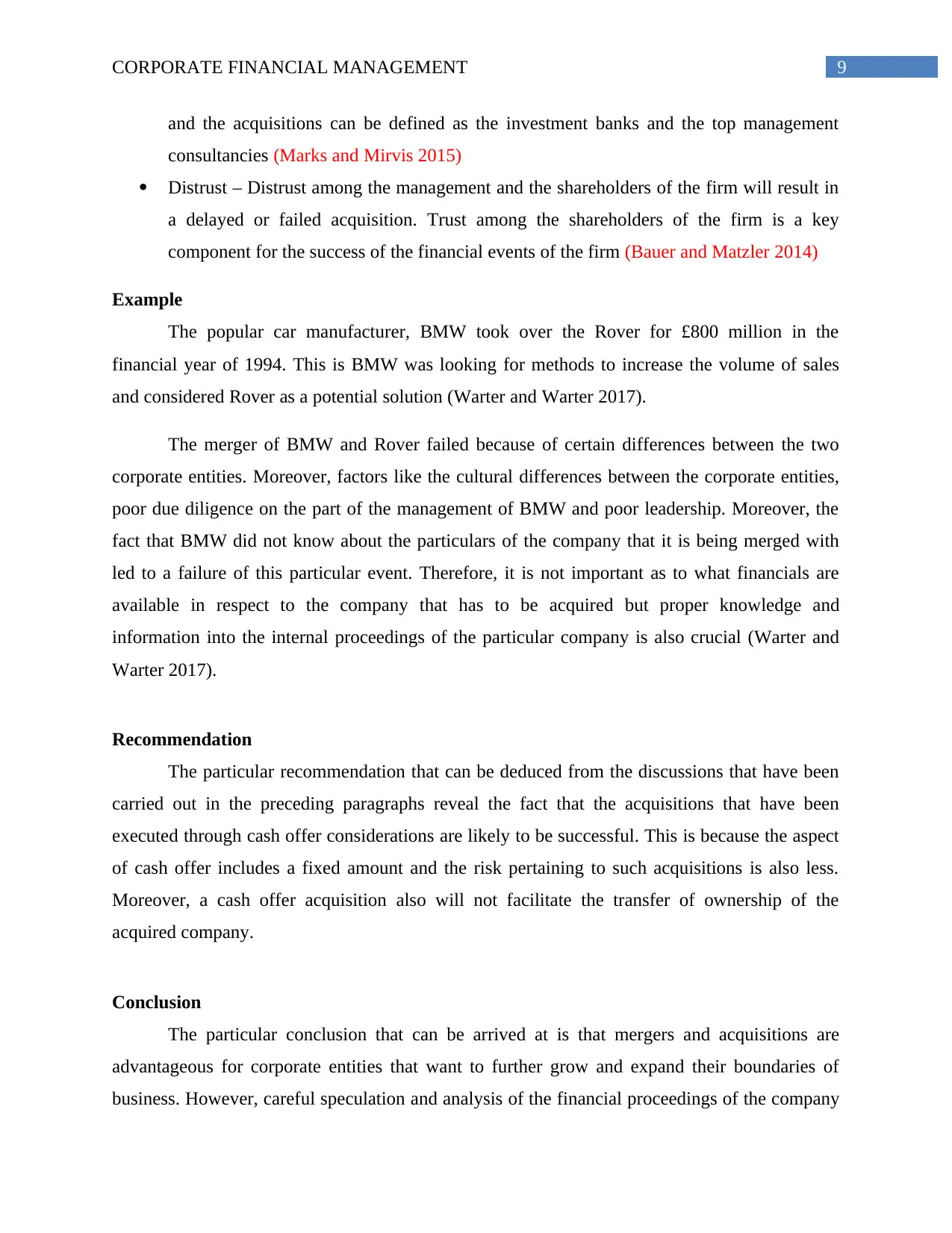
9CORPORATE FINANCIAL MANAGEMENT
and the acquisitions can be defined as the investment banks and the top management
consultancies (Marks and Mirvis 2015)
Distrust – Distrust among the management and the shareholders of the firm will result in
a delayed or failed acquisition. Trust among the shareholders of the firm is a key
component for the success of the financial events of the firm (Bauer and Matzler 2014)
Example
The popular car manufacturer, BMW took over the Rover for £800 million in the
financial year of 1994. This is BMW was looking for methods to increase the volume of sales
and considered Rover as a potential solution (Warter and Warter 2017).
The merger of BMW and Rover failed because of certain differences between the two
corporate entities. Moreover, factors like the cultural differences between the corporate entities,
poor due diligence on the part of the management of BMW and poor leadership. Moreover, the
fact that BMW did not know about the particulars of the company that it is being merged with
led to a failure of this particular event. Therefore, it is not important as to what financials are
available in respect to the company that has to be acquired but proper knowledge and
information into the internal proceedings of the particular company is also crucial (Warter and
Warter 2017).
Recommendation
The particular recommendation that can be deduced from the discussions that have been
carried out in the preceding paragraphs reveal the fact that the acquisitions that have been
executed through cash offer considerations are likely to be successful. This is because the aspect
of cash offer includes a fixed amount and the risk pertaining to such acquisitions is also less.
Moreover, a cash offer acquisition also will not facilitate the transfer of ownership of the
acquired company.
Conclusion
The particular conclusion that can be arrived at is that mergers and acquisitions are
advantageous for corporate entities that want to further grow and expand their boundaries of
business. However, careful speculation and analysis of the financial proceedings of the company
and the acquisitions can be defined as the investment banks and the top management
consultancies (Marks and Mirvis 2015)
Distrust – Distrust among the management and the shareholders of the firm will result in
a delayed or failed acquisition. Trust among the shareholders of the firm is a key
component for the success of the financial events of the firm (Bauer and Matzler 2014)
Example
The popular car manufacturer, BMW took over the Rover for £800 million in the
financial year of 1994. This is BMW was looking for methods to increase the volume of sales
and considered Rover as a potential solution (Warter and Warter 2017).
The merger of BMW and Rover failed because of certain differences between the two
corporate entities. Moreover, factors like the cultural differences between the corporate entities,
poor due diligence on the part of the management of BMW and poor leadership. Moreover, the
fact that BMW did not know about the particulars of the company that it is being merged with
led to a failure of this particular event. Therefore, it is not important as to what financials are
available in respect to the company that has to be acquired but proper knowledge and
information into the internal proceedings of the particular company is also crucial (Warter and
Warter 2017).
Recommendation
The particular recommendation that can be deduced from the discussions that have been
carried out in the preceding paragraphs reveal the fact that the acquisitions that have been
executed through cash offer considerations are likely to be successful. This is because the aspect
of cash offer includes a fixed amount and the risk pertaining to such acquisitions is also less.
Moreover, a cash offer acquisition also will not facilitate the transfer of ownership of the
acquired company.
Conclusion
The particular conclusion that can be arrived at is that mergers and acquisitions are
advantageous for corporate entities that want to further grow and expand their boundaries of
business. However, careful speculation and analysis of the financial proceedings of the company
Secure Best Marks with AI Grader
Need help grading? Try our AI Grader for instant feedback on your assignments.

10CORPORATE FINANCIAL MANAGEMENT
and application of the acquired experience on the part of the managers in regards to the acquired
company is very important. Moreover, failures in the case of merger and acquisition can be
avoided by analysis of the important factors like size and diversity and other related factors.
and application of the acquired experience on the part of the managers in regards to the acquired
company is very important. Moreover, failures in the case of merger and acquisition can be
avoided by analysis of the important factors like size and diversity and other related factors.
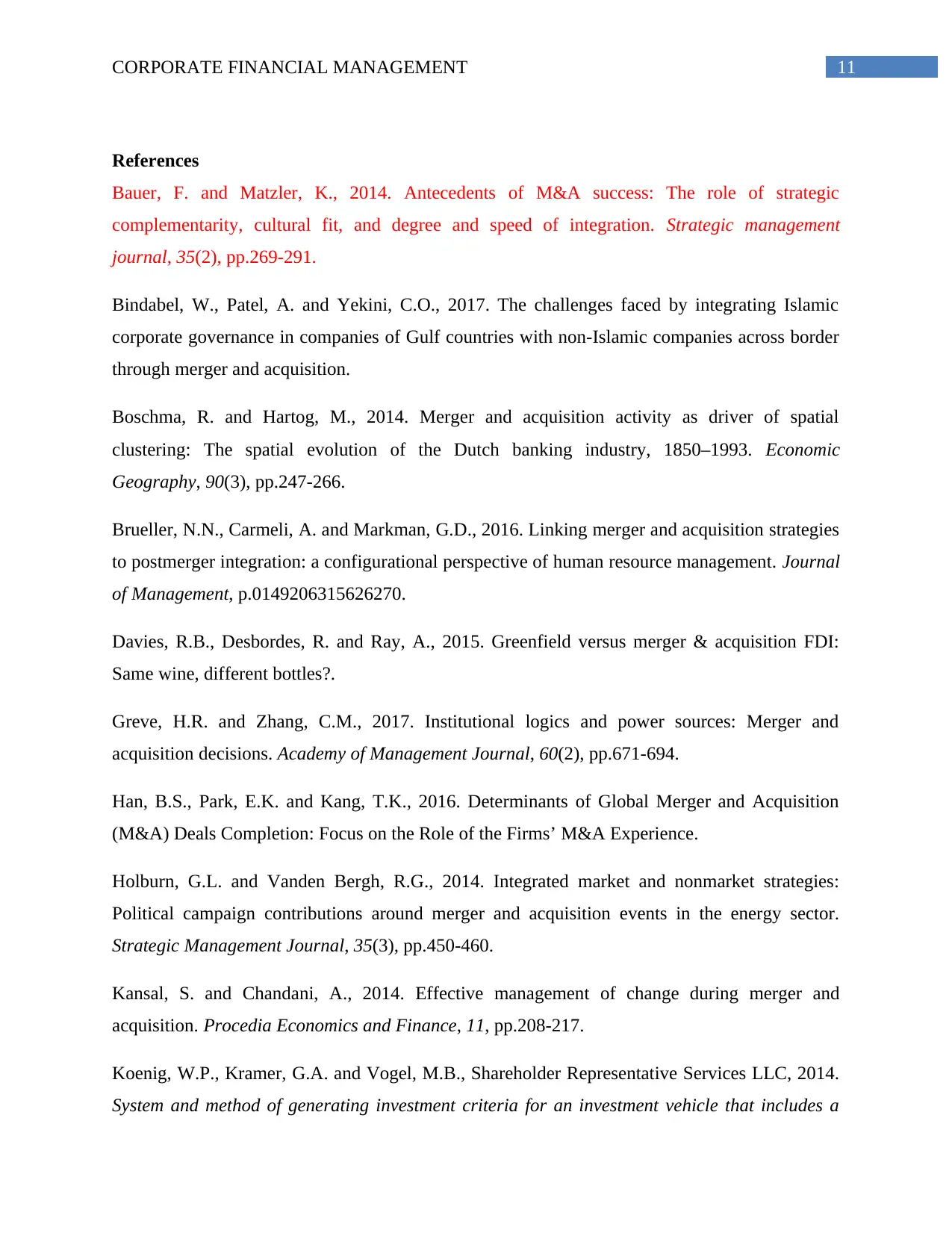
11CORPORATE FINANCIAL MANAGEMENT
References
Bauer, F. and Matzler, K., 2014. Antecedents of M&A success: The role of strategic
complementarity, cultural fit, and degree and speed of integration. Strategic management
journal, 35(2), pp.269-291.
Bindabel, W., Patel, A. and Yekini, C.O., 2017. The challenges faced by integrating Islamic
corporate governance in companies of Gulf countries with non-Islamic companies across border
through merger and acquisition.
Boschma, R. and Hartog, M., 2014. Merger and acquisition activity as driver of spatial
clustering: The spatial evolution of the Dutch banking industry, 1850–1993. Economic
Geography, 90(3), pp.247-266.
Brueller, N.N., Carmeli, A. and Markman, G.D., 2016. Linking merger and acquisition strategies
to postmerger integration: a configurational perspective of human resource management. Journal
of Management, p.0149206315626270.
Davies, R.B., Desbordes, R. and Ray, A., 2015. Greenfield versus merger & acquisition FDI:
Same wine, different bottles?.
Greve, H.R. and Zhang, C.M., 2017. Institutional logics and power sources: Merger and
acquisition decisions. Academy of Management Journal, 60(2), pp.671-694.
Han, B.S., Park, E.K. and Kang, T.K., 2016. Determinants of Global Merger and Acquisition
(M&A) Deals Completion: Focus on the Role of the Firms’ M&A Experience.
Holburn, G.L. and Vanden Bergh, R.G., 2014. Integrated market and nonmarket strategies:
Political campaign contributions around merger and acquisition events in the energy sector.
Strategic Management Journal, 35(3), pp.450-460.
Kansal, S. and Chandani, A., 2014. Effective management of change during merger and
acquisition. Procedia Economics and Finance, 11, pp.208-217.
Koenig, W.P., Kramer, G.A. and Vogel, M.B., Shareholder Representative Services LLC, 2014.
System and method of generating investment criteria for an investment vehicle that includes a
References
Bauer, F. and Matzler, K., 2014. Antecedents of M&A success: The role of strategic
complementarity, cultural fit, and degree and speed of integration. Strategic management
journal, 35(2), pp.269-291.
Bindabel, W., Patel, A. and Yekini, C.O., 2017. The challenges faced by integrating Islamic
corporate governance in companies of Gulf countries with non-Islamic companies across border
through merger and acquisition.
Boschma, R. and Hartog, M., 2014. Merger and acquisition activity as driver of spatial
clustering: The spatial evolution of the Dutch banking industry, 1850–1993. Economic
Geography, 90(3), pp.247-266.
Brueller, N.N., Carmeli, A. and Markman, G.D., 2016. Linking merger and acquisition strategies
to postmerger integration: a configurational perspective of human resource management. Journal
of Management, p.0149206315626270.
Davies, R.B., Desbordes, R. and Ray, A., 2015. Greenfield versus merger & acquisition FDI:
Same wine, different bottles?.
Greve, H.R. and Zhang, C.M., 2017. Institutional logics and power sources: Merger and
acquisition decisions. Academy of Management Journal, 60(2), pp.671-694.
Han, B.S., Park, E.K. and Kang, T.K., 2016. Determinants of Global Merger and Acquisition
(M&A) Deals Completion: Focus on the Role of the Firms’ M&A Experience.
Holburn, G.L. and Vanden Bergh, R.G., 2014. Integrated market and nonmarket strategies:
Political campaign contributions around merger and acquisition events in the energy sector.
Strategic Management Journal, 35(3), pp.450-460.
Kansal, S. and Chandani, A., 2014. Effective management of change during merger and
acquisition. Procedia Economics and Finance, 11, pp.208-217.
Koenig, W.P., Kramer, G.A. and Vogel, M.B., Shareholder Representative Services LLC, 2014.
System and method of generating investment criteria for an investment vehicle that includes a
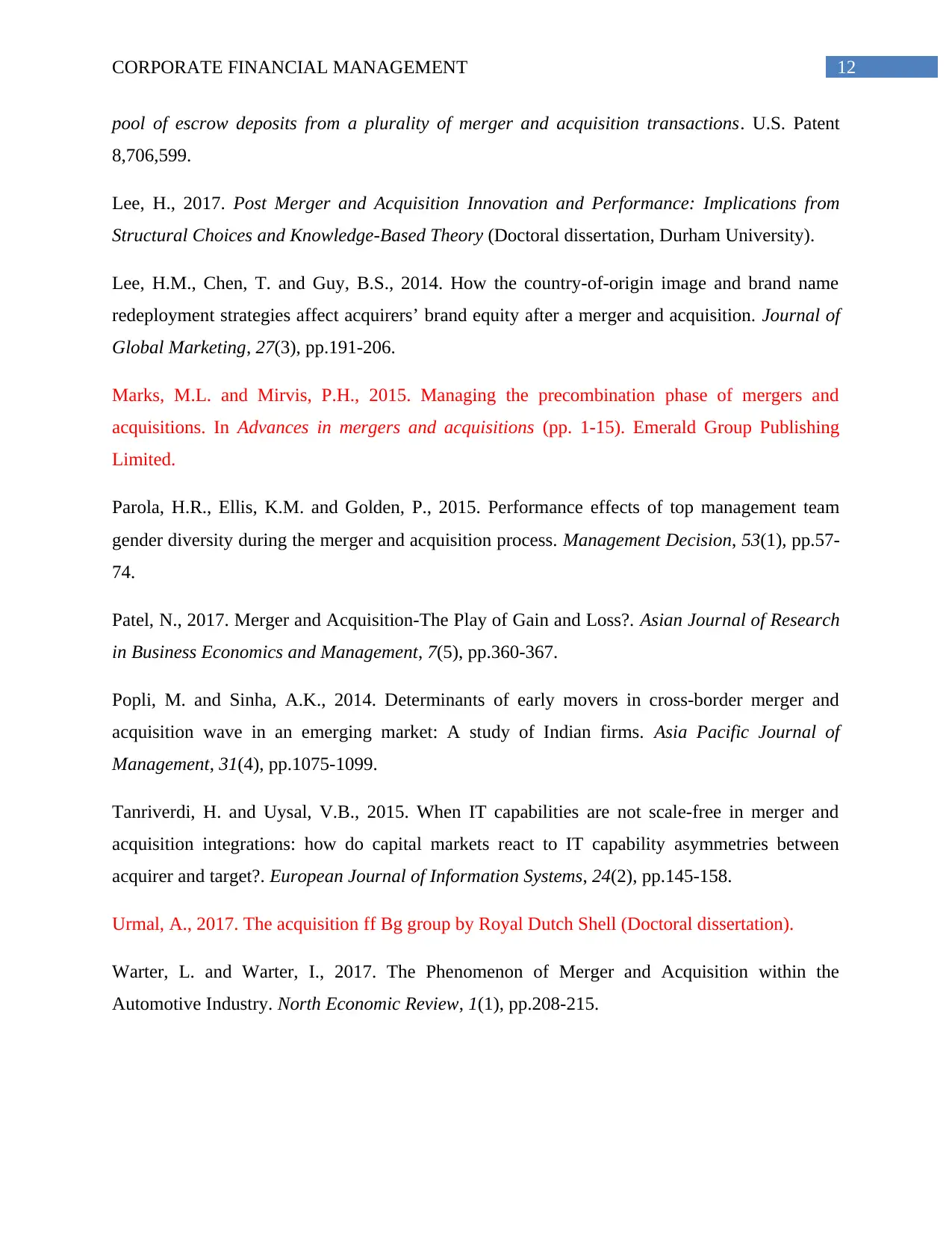
12CORPORATE FINANCIAL MANAGEMENT
pool of escrow deposits from a plurality of merger and acquisition transactions. U.S. Patent
8,706,599.
Lee, H., 2017. Post Merger and Acquisition Innovation and Performance: Implications from
Structural Choices and Knowledge-Based Theory (Doctoral dissertation, Durham University).
Lee, H.M., Chen, T. and Guy, B.S., 2014. How the country-of-origin image and brand name
redeployment strategies affect acquirers’ brand equity after a merger and acquisition. Journal of
Global Marketing, 27(3), pp.191-206.
Marks, M.L. and Mirvis, P.H., 2015. Managing the precombination phase of mergers and
acquisitions. In Advances in mergers and acquisitions (pp. 1-15). Emerald Group Publishing
Limited.
Parola, H.R., Ellis, K.M. and Golden, P., 2015. Performance effects of top management team
gender diversity during the merger and acquisition process. Management Decision, 53(1), pp.57-
74.
Patel, N., 2017. Merger and Acquisition-The Play of Gain and Loss?. Asian Journal of Research
in Business Economics and Management, 7(5), pp.360-367.
Popli, M. and Sinha, A.K., 2014. Determinants of early movers in cross-border merger and
acquisition wave in an emerging market: A study of Indian firms. Asia Pacific Journal of
Management, 31(4), pp.1075-1099.
Tanriverdi, H. and Uysal, V.B., 2015. When IT capabilities are not scale-free in merger and
acquisition integrations: how do capital markets react to IT capability asymmetries between
acquirer and target?. European Journal of Information Systems, 24(2), pp.145-158.
Urmal, A., 2017. The acquisition ff Bg group by Royal Dutch Shell (Doctoral dissertation).
Warter, L. and Warter, I., 2017. The Phenomenon of Merger and Acquisition within the
Automotive Industry. North Economic Review, 1(1), pp.208-215.
pool of escrow deposits from a plurality of merger and acquisition transactions. U.S. Patent
8,706,599.
Lee, H., 2017. Post Merger and Acquisition Innovation and Performance: Implications from
Structural Choices and Knowledge-Based Theory (Doctoral dissertation, Durham University).
Lee, H.M., Chen, T. and Guy, B.S., 2014. How the country-of-origin image and brand name
redeployment strategies affect acquirers’ brand equity after a merger and acquisition. Journal of
Global Marketing, 27(3), pp.191-206.
Marks, M.L. and Mirvis, P.H., 2015. Managing the precombination phase of mergers and
acquisitions. In Advances in mergers and acquisitions (pp. 1-15). Emerald Group Publishing
Limited.
Parola, H.R., Ellis, K.M. and Golden, P., 2015. Performance effects of top management team
gender diversity during the merger and acquisition process. Management Decision, 53(1), pp.57-
74.
Patel, N., 2017. Merger and Acquisition-The Play of Gain and Loss?. Asian Journal of Research
in Business Economics and Management, 7(5), pp.360-367.
Popli, M. and Sinha, A.K., 2014. Determinants of early movers in cross-border merger and
acquisition wave in an emerging market: A study of Indian firms. Asia Pacific Journal of
Management, 31(4), pp.1075-1099.
Tanriverdi, H. and Uysal, V.B., 2015. When IT capabilities are not scale-free in merger and
acquisition integrations: how do capital markets react to IT capability asymmetries between
acquirer and target?. European Journal of Information Systems, 24(2), pp.145-158.
Urmal, A., 2017. The acquisition ff Bg group by Royal Dutch Shell (Doctoral dissertation).
Warter, L. and Warter, I., 2017. The Phenomenon of Merger and Acquisition within the
Automotive Industry. North Economic Review, 1(1), pp.208-215.
Paraphrase This Document
Need a fresh take? Get an instant paraphrase of this document with our AI Paraphraser
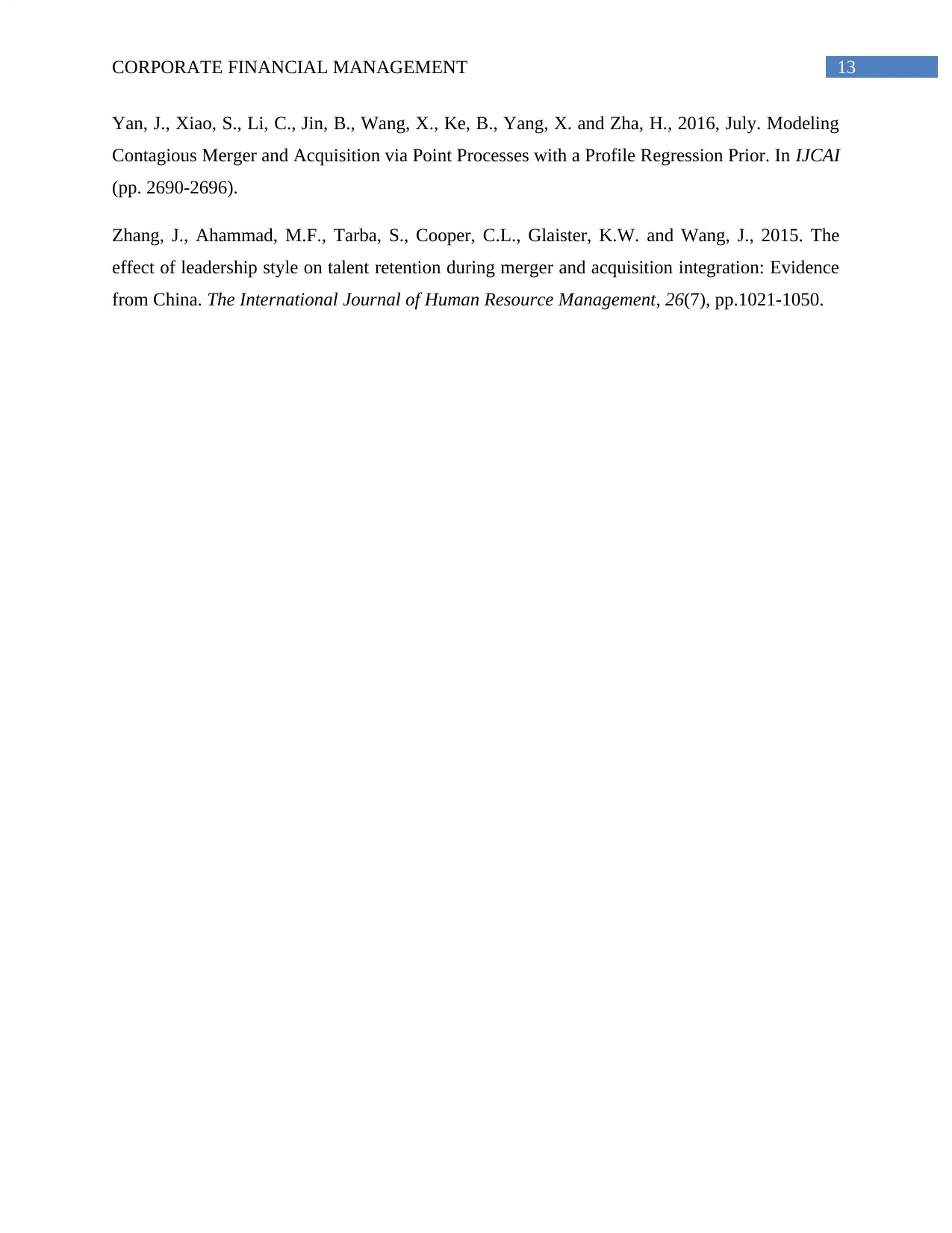
13CORPORATE FINANCIAL MANAGEMENT
Yan, J., Xiao, S., Li, C., Jin, B., Wang, X., Ke, B., Yang, X. and Zha, H., 2016, July. Modeling
Contagious Merger and Acquisition via Point Processes with a Profile Regression Prior. In IJCAI
(pp. 2690-2696).
Zhang, J., Ahammad, M.F., Tarba, S., Cooper, C.L., Glaister, K.W. and Wang, J., 2015. The
effect of leadership style on talent retention during merger and acquisition integration: Evidence
from China. The International Journal of Human Resource Management, 26(7), pp.1021-1050.
Yan, J., Xiao, S., Li, C., Jin, B., Wang, X., Ke, B., Yang, X. and Zha, H., 2016, July. Modeling
Contagious Merger and Acquisition via Point Processes with a Profile Regression Prior. In IJCAI
(pp. 2690-2696).
Zhang, J., Ahammad, M.F., Tarba, S., Cooper, C.L., Glaister, K.W. and Wang, J., 2015. The
effect of leadership style on talent retention during merger and acquisition integration: Evidence
from China. The International Journal of Human Resource Management, 26(7), pp.1021-1050.
1 out of 14
Related Documents
Your All-in-One AI-Powered Toolkit for Academic Success.
+13062052269
info@desklib.com
Available 24*7 on WhatsApp / Email
![[object Object]](/_next/static/media/star-bottom.7253800d.svg)
Unlock your academic potential
© 2024 | Zucol Services PVT LTD | All rights reserved.





